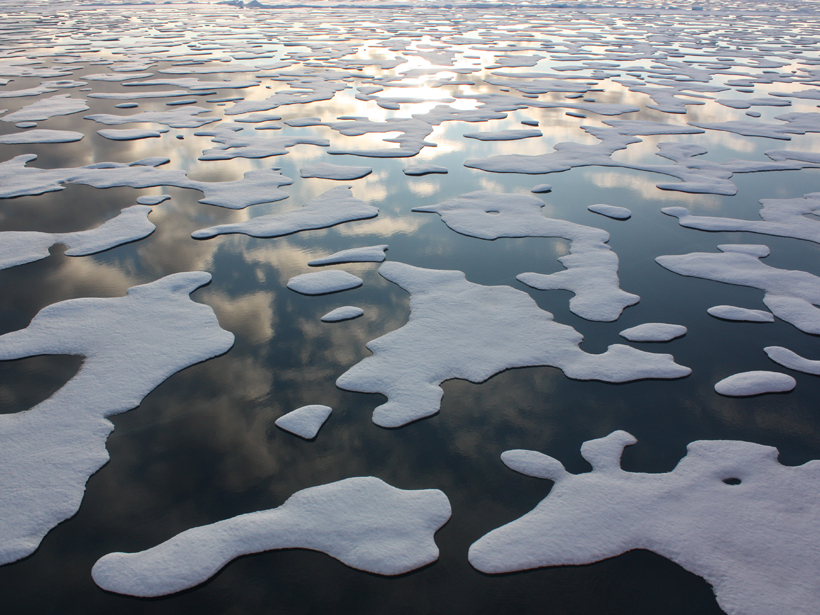Sea ice faces a grim future as global temperatures rise. The warming temperatures melt the ice and force it to retreat further poleward. Images of skinny polar bears often accompany news of sea ice disappearing, but a new study predicts a less bleak impact of the retreating ice on Arctic weather and precipitation.
“We think the amount of moisture coming from the Arctic is increasing significantly over [that of] the last two decades, and we expect that to only continue as sea ice is lost.”
A recent study examined the origins of moisture in the Arctic atmosphere, which falls as rain or snow. The team of researchers, led by Ben Kopec, a graduate student in Dartmouth University’s Earth Sciences Department, found that as sea ice retreats, more moisture evaporates from Arctic waters. This moisture then contributes more heavily as a source for precipitation. The researchers predict more atmospheric moisture will lead to an increase in the overall amount of precipitation falling in the Arctic. Their study was published in the Proceedings of the National Academy of Sciences of the United States of America.
“The overall picture is we think the amount of moisture coming from the Arctic is increasing significantly over [that of] the last two decades, and we expect that to only continue as sea ice is lost,” said Kopec.
Kopec and his colleagues examined the isotopic ratios of hydrogen and oxygen to determine where the source waters for Arctic precipitation are. Water with heavier isotopes would come from the subtropics, the other major source of Arctic moisture, because the warmer ocean temperatures allow that heavier water to break free from the ocean and evaporate.
The team investigated data spanning the past 2 decades, and “we saw in that a very strong correlation between decreasing sea ice and decreasing d-excess,” said Kopec, referring to a value incorporating the ratios of both hydrogen and oxygen isotopes. A lower d-excess value means that lighter isotopes predominate and that the water most likely originated in the Arctic instead of the subtropics. By this measure, the proportion of water originating in the Arctic increased by 18.2% and 10.8% per 100,000 square kilometers of sea ice lost in the Greenland Sea and the Canadian Arctic over the past 2 decades.
Kopec and his colleagues used these numbers to predict how much precipitation will change as sea ice retreats and Arctic-derived moisture increases. They found that precipitation in the Arctic would increase anywhere from about 16% to 28%, depending on how evaporation in the subtropics changes.
The specific form this precipitation takes can further affect the Arctic environment, said Kopec. If it falls as rain, Arctic snow will melt earlier, and the region won’t reflect solar radiation away from the surface as effectively. This could compound the warming effects of increasing greenhouse gases. But if more snow falls, the increased albedo of the Arctic would reflect more radiation off the surface and cause regional cooling. “This is a potential mechanism to at least mitigate some of the global warming effects of carbon dioxide at some of these sites,” said Kopec.
Changes in albedo and temperature might also affect storms and precipitation in midlatitude regions. Xiangdong Zhang, a climate scientist at the University of Alaska Fairbanks, recently presented research at the American Geophysical Union’s annual Fall Meeting showing how sea ice retreat could decrease storm activity over Eurasia. Warming Arctic waters decrease the temperature gradient from north to south, causing less conversion of energy in those midlatitudes and decreasing storm formation. This could trigger a positive feedback loop between stormless high-pressure systems and colder temperatures over Eurasia. The link between sea ice retreat and decreased storm activity in Asia is noticeable, but researchers haven’t discovered much of a link to North America or Europe yet, and the connection between Arctic sea ice and midlatitude storm activity remains under debate.
“This study deserves a lot of credit for bringing a new approach to the evaluation of Arctic precipitation.”
Kopec’s study provides quantitative data on Arctic moisture source waters, and even though it provides indirect support for subsequent predictions of increasing precipitation, the conclusion is still valid, said John Walsh, an Arctic researcher from the University of Alaska Fairbanks, who was not involved in the study. The atmosphere can only hold so much water before it falls as precipitation, and it is entirely logical that this increase in Arctic-sourced water will cause an increase in snow or rain, said Walsh. Not only are the predictions logical, said Walsh, but they match up with how climate models say Arctic precipitation will change.
The method Kopec and his colleagues used—evaluating moisture contributions using isotopes to predict precipitation—is extremely valuable, said Walsh. “I think on balance this study deserves a lot of credit for bringing a new approach to the evaluation of Arctic precipitation.” Arctic precipitation measurements are notoriously difficult because of cold temperatures and windy conditions blowing precipitation around.
Walsh currently works on climate and meteorological assessment studies in the Arctic and how the environment is changing. He said that this study is important for his own work because it provides a way around the challenges of directly measuring Arctic precipitation. “It is saying there may be more to the story than what the actual gauge measurements are telling us about precipitation.” He would like to see this study expanded because it’s “a prototype that really does deserve to be extended.”
—Cody Sullivan, Writer Intern
Citation: Sullivan, C. (2016), Vanishing sea ice could trigger more Arctic precipitation, Eos, 97, doi:10.1029/2016EO042877. Published on 4 January 2016.
Text © 2016. The authors. CC BY-NC 3.0
Except where otherwise noted, images are subject to copyright. Any reuse without express permission from the copyright owner is prohibited.

